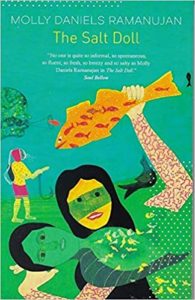The Salt Doll
Molly Daniels Ramanujan
|
|
The Salt Doll is the story of Mira Cheriyan. Taken to Aden to live with her parents, she rebels against them, tries to run away, and is finally sent to school in India. But this iconoclast cannot adapt to the disciplining environment of a single school: “At the first boarding school, the nuns wanted us to be truthful. If we told lies, they powdered quinine and rubbed it on our tongues.” She encounters various disasters in the nine boarding schools she changes: their strictures “did not bother anyone else at the school, but it did me”. Reading thereby turns “into a crusade, a declaration of independence” and provokes her to venture into the forbidden. Rejected by the world, Mira is mostly brought up by her grandfather, the only real parent she has known since she has been abandoned by her mother at the age of four. But she secretly begins to enjoy the freedom of being a cast-out: “If you have no parents, you have freedom.” Ordered to read only the literature approved by the Mother Superior in one of her schools, she begins to hate impositions, and protests repeatedly, sometimes even hoaxing high fever to escape “from the world we suddenly found impossible to accept.” Correspondingly, the dance movement of the novel works through events and characters that coalesce and part while the literary tensions between relations and races remain vividly in the background. Various accounts of child misconduct, of antipathy towards the parents, of ceremonies and rituals across cultures, are replete with the instinctual and the savage. Molly Daniels’s art of storytelling finds a reflection in the novel’s kaleidoscopic depiction of behaviour, sexual responses and the literary imagination through a technique of merging the concrete and the intangible. Rumina Sethi | 16-Dec-2018 | The Tribune
|

